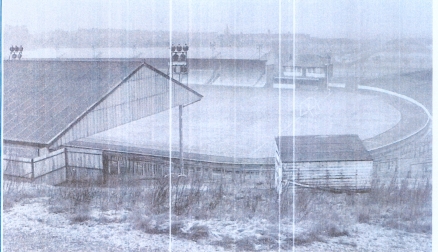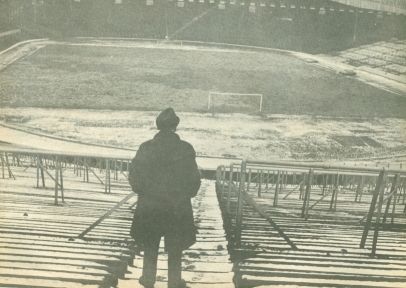Leaving The White City
The White City and the M8 Western Extension
The proposal, that the M8 Western extension would be routed through the north eastern corner of the White City site, had been known for some time before Danny Taylor made he first public statement about it, on taking over the promotorial reins from Trevor Redmond in 1967. He was fairly certain that only minor changes, like shortening the track and resiting the pits at third bend, would be required. Sadly, he was to be proven wrong in his assumptions. By the following year, Les Whaley had succeeded Taylor, and, in replying to a supporters letter on the subject, said that the Tigers would have to move from the Paisley Road West venue, but not for “some years yet”
Alternative Venues
During the winter of 1967/68, Ian Hoskins had scoured football grounds all over Central Scotland in his search for a new home for his Edinburgh Monarchs following the closure of Old Meadowbank for redevelopment. Albion Rovers Cliftonhill ground in Coatbridge was finally secured, but this was very much the last card in the pack. Any new venue for the Tigers would have to lie within the Glasgow city boundary. So what venues were likely to be under consideration?
Prior to bringing speedway back to Glasgow in 1964, Trevor Redmond had approached Celtic FC, whose Parkhead stadium had previously staged speedway in 1928. However the Celtic board were not interested this time around. With the club now riding the crest of a wave following their historic European Cup win in 1967, there was even less prospect of them being interested. Rangers FC, while very much in their rivals shadow at this time, were unlikely to be any different. Queens Park FC was the only amateur team to play in senor Scottish football and was still a force in the old Second Division. However they seemed to stick firmly to their Corinthian ideals and it was felt they would rebuff any approach to use Hampden.
Ashfield was not a possibility, as a greyhound track had been laid on top of the speedway circuit. Little was known about Carntyne and no mention was ever made about it being a prospective venue.
All of this left Cathkin Park as the best option. It was now disused, being the former home of Third Lanark FC who went into liquidation at the end of the 1965/66 season. The stand ran the length of the home straight and would provide cover for about 2500. The stadium nestled on the northern slope of Hampden Terrace, which formed a natural amphitheatre and provided ample, if uncovered, back straight terracing. There was a narrow track around the football pitch, but with football no longer being played, the pitch could be lifted to provide a track of ample width. It would also have been possible to extend the apex of the corners into the terracing at either end. In short, a track similar in size and shape to Old Meadowbank could be housed at Cathkin. The Speedway Star of 22nd November 1968 reported that the Tigers promotion were weighing up an approach to the Cathkin owners

What might have been the third and fourth bends, with the possible pits area adjacent to the clubhouse at the fourth bend.
Fire! Fire! Fire!
The activities of an arsonist during the winter of 1968 may well have altered the course of the history of Glasgow Speedway. On the night of the 21st October 1968, Hampden was badly damaged by a blaze, which destroyed much of the centre stand, the visitors’ dressing rooms and the main administration offices. I can remember seeing the flames from my bedroom and hearing the fire engines arriving just before midnight. The League Cup Final was due to be staged a few days later and its postponement added to Queens Park’s cash flow worries.
Any thoughts that the fire had been accidental were dispelled when there was a similar fire at Ibrox Stadium the following night and the Cathkin stand was gutted a few weeks later. Cathkin was now no longer a viable option, while Queens:Park was a club with financial problems and no real prospect of finding additional revenue streams.
Queens Park 1 Albion Rovers 1
On 18th January 1969 Queens Park and Albion Rovers fought out a 1-1 draw in front of just over 1000 fans. No doubt the result was a delight for those who had picked this game on their Treble Chance selections, where eight draws would be your passport to great riches!
However this game was to be a pivotal point in the Tigers history. Tom Fagan, the Albion Rovers chairman and the Monarchs landlord, had invited Ian Hoskins to make the short trip from his Shawlands home to be his guest at this game. He introduced Hoskins to the Queens Park officials saying this was the man whose speedway had saved his football team. This certainly got plenty of attention and Hoskins both literally and metaphorically decided to strike while the iron was hot! Queens Park was not hard to deal with and within four weeks the Speedway Star carried the news that Hampden was to be Tigers new home.

Hoskins surveys Hampden amid the late February snows
The Hampden Track
I was fifteen when my family moved to Kings Park in April 1966 and in the following months I went down to Hampden to see the many end of season cup finals that were staged there, often waiting until the gates were opened twenty minute from the end to allow the crowd to start leaving! On the occasions that I paid for entry, I would usually spend the half time interval wondering if it would be possible to stage speedway at Hampden. I would conclude that there were too many insurmountable problems for it to be viable. The speedway fence would restrict the view from the terracing and would therefore be quite unacceptable to the authorities. It never occurred to me that a portable fence could be installed!
Along the home straight and round both bends the terracing ended up about three feet below the level of the track and a fearsome drop awaited any rider unlucky enough to be thrown over the fence. I wondered whether the football authorities would allow the first six rows of the terracing at both bends to be built up. This would give a better width on the bends and would also avoid the problem of the drop”. However it was unlikely that the home straight could be treated similarly. In short, even to my youthful and optimistic mind, there was no real possibility of speedway being staged at Hampden – how wrong I was!
The problem of a rider being thrown over the fence never seems to have been considered, despite the dire possibilities of hitting the cast iron crowd barriers, or worst still, the spiked railings, which divided the terracing into manageable sections. The fence was exceptionally well designed, being made in sections of about 12 feet, each being mounted on two poles, which slotted into retaining holes made in the track perimeter. Each fence section was numbered so that it would always be placed in the correct place. The track, formerly a 440 yards running track, had some turfs lifted from behind the goals and now measured 420 yards. It must be said that it always looked a bit on the narrow side. John Berry in his book “More Confessions” describes it as “too long and skinny to be a good race track, but I have certainly seen a lot worse around football pitches”, which is probably a fair summing up.